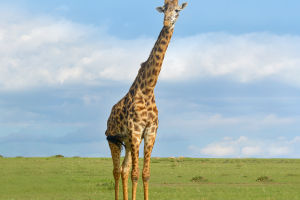Dragonflies are among the most ancient insects on Earth, with ancestors dating back more than 300 million years.
With their jewel-like bodies, dragonflies are mesmerizing to watch as they zip through the air with astonishing agility.
But what truly sets them apart is their exceptional vision—one of the most complex and capable in the insect world. Their extraordinary eyes allow them to track fast-moving prey, navigate complex environments, and react with split-second precision.
In this article, we'll explore how dragonflies see the world and why their vision is perfectly adapted for survival.
The Eyes of a Predator
Dragonflies rely on their vision for nearly every aspect of their lives. Unlike most creatures, whose eyes are positioned on either side of their head, a dragonfly's eyes cover almost its entire head, giving it an impressive 360-degree field of view. This nearly all-encompassing sight means that dragonflies can see in almost every direction simultaneously—a significant advantage when hunting.
Dragonfly eyes are also massive in proportion to their head size. Each eye is made up of around 30,000 ommatidia—tiny lenses that form part of a compound eye. Each ommatidium is capable of processing light and movement, creating a mosaic of images that merge into one detailed panorama. This type of vision may look pixelated to humans, but it allows dragonflies to detect the slightest movements in their surroundings, an essential skill for a predator.
Seeing in Slow Motion
One fascinating aspect of dragonfly vision is that they experience the world in "slow motion" compared to humans. While this doesn't mean time is slower for them, it refers to the rapid rate at which they can process visual information. This ability, known as a high flicker-fusion rate, allows them to see up to 300 frames per second, whereas humans process only around 60 frames per second. Essentially, this heightened perception enables dragonflies to react with incredible speed, spotting prey and dodging obstacles with ease.
This "slow-motion" view is crucial during hunting, as it allows dragonflies to predict the movement of their prey accurately. By calculating the trajectory of a mosquito or fly in real-time, they can intercept it mid-flight—a skill that makes them deadly hunters. It's estimated that dragonflies have a hunting success rate of about 95%, making them some of the most effective predators in the animal kingdom.
UV and Polarized Light Detection
Dragonflies don't just see more frames per second—they also perceive colors and light differently than humans. For instance, while humans have three types of photoreceptors (cones) for detecting colors, dragonflies possess up to 30 different types. This expanded color perception allows them to see ultraviolet (UV) light, which is invisible to the human eye. UV light detection helps dragonflies recognize the reflective patterns on water surfaces, allowing them to find breeding spots and hunt efficiently.
In addition to UV vision, dragonflies can see polarized light, which is the way light scatters through the sky. Polarized light helps them to navigate and orient themselves relative to the sun, even on cloudy days. This ability is especially useful for migratory dragonfly species that travel long distances, as it enables them to stay on course.
Tracking and Targeting in Mid-Air
One of the most extraordinary aspects of dragonfly vision is their ability to lock onto a moving target and follow it. Dragonflies don't just see where their prey is—they can anticipate where it's going. Through a process called selective attention, they can focus on a single target, even if it's among many other moving objects. This skill allows them to track their prey's flight path accurately, anticipating its future position and adjusting their trajectory accordingly.
Imagine a dragonfly zeroing in on a mosquito darting through the air. As the mosquito changes direction, the dragonfly adjusts its flight path, maintaining a steady pursuit until it can snatch the insect from the air with astonishing precision. Dragonflies even calculate the angle and speed needed to intercept their prey, showcasing an advanced form of visual processing usually associated with larger animals.
Eyes Built for Survival
The remarkable vision of dragonflies is a testament to evolution's ability to craft specialized tools for survival. Each aspect of their vision—from the 360-degree field of view and high flicker-fusion rate to UV and polarized light detection—plays a vital role in their survival and efficiency as hunters. This finely tuned visual system allows dragonflies to thrive in their habitats and maintain their status as formidable predators.
When you see a dragonfly flitting about on a summer day, it's likely aware of every movement around it, from the buzz of a nearby fly to the motion of leaves rustling in the wind. Their vision doesn't just help them hunt; it connects them to their environment in a way that few other creatures experience.
For centuries, people have admired dragonflies for their beauty and grace, often unaware of the sophisticated biology that enables their agility and precision. Dragonflies see the world in a way humans can't imagine, filled with colors, patterns, and movement beyond our perception. And while we might never fully grasp their world, we can appreciate the astonishing adaptations that have made dragonflies one of nature’s most remarkable creatures.


